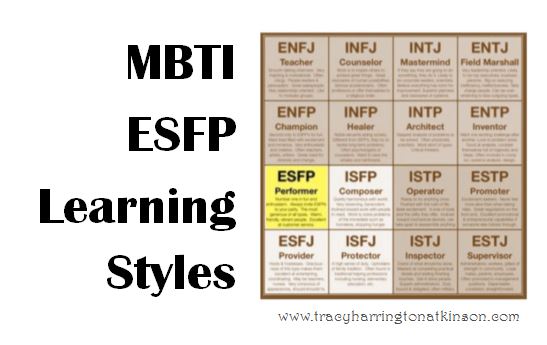ESFP (Extraversion, Sensing, Feeling, Perceiving) Learning Style
Outgoing, friendly, and accepting. Exuberant lovers of life, people, and material comforts. Enjoy working with others to make things happen. Bring common sense and a realistic approach to their work, and make work fun. Flexible and spontaneous, adapt readily to new people and environments. Learn best by trying a new skill with other people.
~Excerpted from Introduction to Type®
by Isabel Briggs Myers
_______________________________________________
Frequency
| ESFP – | 8.5% of the total population |
| 6.9% of the male population | |
| 10.1% of the female population |
| Extraversion (E) | 49.3% of the total population |
| Sensing (S) | 73.3% of the total population |
| Feeling (F) | 59.8% of the total population |
| Perceiving (P) | 45.9% of the total population |
_______________________________________________
The estimated frequency table was compiled from a variety of MBTI® results from 1972 through 2002, including data banks at the Center for Applications of Psychological Type; CPP, Inc; and Stanford Research Institute (SRI).
Learner Keyword: adaptive and responsive1
Learner Question
ESFPs, while learning, address the question, “Am I enjoying this?”2
Learning Style
ESFPs are practical learners above all else. They ESFPs prefer practical applications and real-world experiences. Although ESFPs possess an incredible wealth of information and general knowledge, they still need a logical flow for the knowledge to be integrated into existing schemas.
ESFPs are highly social, needing interactions and to be physically active in learning. They are observant and spontaneous. They value new experiences and verbally processing information.
ESFPs are driven by the educational possibility of using knowledge to bring joy to others.
Cognitive Environment
ESFPs prefer to learn in a fast-paced, interactive environment with frequent breaks and possibilities for physical activity. They enjoy excitement and drama. Short presentations appeal to this interactive learner along with a variety of sensory stimulating instructional methodologies. Using a variety of interactive learning opportunities such as discussions, debates, contests, educational games and group work solidify knowledge.
Despite these interactive venues, ESFPs need a high amount of structure, objectives and guidelines. They prefer to accurately understand what is expected of them, enjoying rubrics, objectives and feedback from their instructor.

For other learning styles: MBTI Learning Styles – A Practical Approach Available in paperback; Kindle; and pdf versions
ESFPs are concrete, visual learners. They need a time during class to ask questions.
ESFPs are most comfortable:
- Knowing the expectations required of their work and classroom mores
- Group activities and continual interaction
- Field trips are highly beneficial for the ESFP.
- Practicing skills
- Experiencing and doing things
- Problem-solving, especially new, intriguing and novel problems
- Having a practical application to their lives
- Being the center of attention
ESFPs are least comfortable:
- Observing, passive environments
- Too much time for reflection, pondering and quiet
- Theory
- Discussions without guidelines
- Detailed-tasks
- Independent work
- Theory and abstract rules
Learn More:
For more information on teacher and classroom tips, learner tips, instructional strategies and assessment strategies, see MBTI Learning Styles: A Practical Approach or learn more on Udemy.
Click on one of the sixteen personality types for more information:
Click on one of these dimension for more information:

For other learning styles: MBTI Learning Styles – A Practical Approach Available in paperback; Kindle; and pdf versions
For other learning styles: MBTI Learning Styles – A Practical Approach Available in paperback; Kindle; and pdf versions
References
Bonwell, C. & Eison, J. (1991). Active Learning: Creating Excitement in the Classroom. ERIC Digest. ERIC Clearinghouse on Higher Education, Washington, D.C
Career Assessment. (2017). The 16 Myers-Briggs Type Indicator Personality Types (MBTI personality types). Retrieved from: http://careerassessmentsite.com/tests/myers-briggs-tests/about-the-myers-briggs-type-indicator/the-16-myers-briggs-personality-types/
CPP, Inc. (2017). Linking MBTI® Personality Type to Learning Style – Strategies and Insights. Retrieved from: http://www.cppblogcentral.com/cpp-connect/linking-mbti-personality-type-to-learning-style-strategies-and-insights/
Defiance College. (2106). What’s Your Personality Type? Retrieved from: http://library.defiance.edu/learningstyles/myersbriggs
Gregory, G. (2008). Differentiated instructional strategies in practice: training, implementation, and supervision (2nd ed.). Thousand Oaks, CA: Corwin Press. p. 97-99.
Humanmetrics. (2017). Learning Styles. Retrieved from: http://www.humanmetrics.com/personality/learning-styles
Kiser, H. (2017). Choice board. Retrieved from: https://hillarykiser.blogspot.com/2012/10/choice-board.html?showComment=1491939410939#c9063789945839625994
Krafka, K. (2017) Learning Menus. Retrieved from: http://prescriptionforgiftedsuccess.weebly.com/learning-menus.html
Litemind. (2017). What is mind mapping? Retrieved from: https://litemind.com/what-is-mind-mapping/
Martinez, M. (2006). What is metacognition. Phi Delta Kappan, 64(10), 696-699.
Melvin, J. (2017). Personality Type as an Indicator of Learning Style. University of Rochester. Retrieved from: file:///C:/Users/Tracy/Downloads/JMelvinSGf13paper%20(2).pdf
Myers & Briggs Foundation. (2017). How frequent is my type? Retrieved from: http://www.myersbriggs.org/my-mbti-personality-type/my-mbti-results/how-frequent-is-my-type.htm
Myers & Briggs Foundation. (2017). Type and Learning. Retrieved from: http://www.myersbriggs.org/type-use-for-everyday-life/type-and-learning/
Myers, I. (1998). Introduction to Type: A Guide to Understanding Your Results on the MBTI Instrument. Consulting Psychologists Press.
Myers, I., McCaulley, M., Quenk, N. & Hammer, A. (2009). MBTI Manual: A Guide to the Development and Use of the Myers-Briggs Type Indicator Instrument. Consulting Psychologists Press.
Okoro, C. & Chukwudi, E. K. (2011). Metacognitive skills: A viable tool for self-directed learning. Journal of Educational and Social Research, 1(4), 71-76.
Pelley, J.W. (2008). The Success Types Learning Style Type Indicator. Retrieved from: Texas Tech University. https://www.ttuhsc.edu/som/success/lsti.aspx
Smith, C. V. & Cardaciotto, L. (2011). Is active learning like broccoli? Student perceptions of active learning in large lecture classes. Journal of the Scholarship of Teaching and Learning, 11(1), 53-61.
University of Texas. (2017). Experiential Learning. Retrieved from: https://facultyinnovate.utexas.edu/teaching/strategies/overview/experiential-learning
Western Nevada College. (2017). Personality Types and Learning. Retrieved from: http://www.wnc.edu/mbti/personality-types/
Tracy Atkinson is certified in Myers Briggs Type Indicator (MBTI) by CPP, Inc. The findings on learning styles derive from research, experience and observations.
Tracy Atkinson, a mother of six, lives in the Midwest with her husband and spirited dachshunds. She is a teacher, having taught elementary school to higher education, holding degrees in elementary education and a master’s in higher education. Her passions include researching, studying and investigating the attributes of self-directed learners. She has published several titles, including: The Art of Learning Journals, Calais: The Annals of the Hidden, Rachel’s 8 and Securing Your Tent. She is currently exploring the attributes of self-directed learners: The Five Characteristics of Self-Directed Learners.

Comments are closed